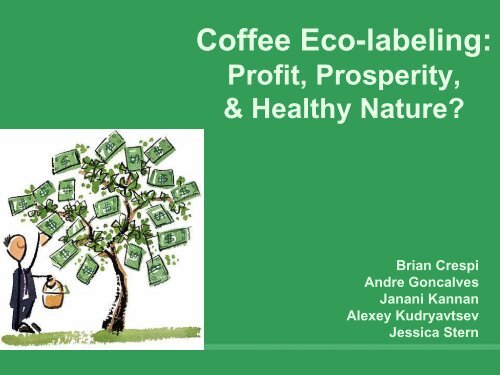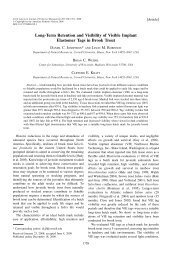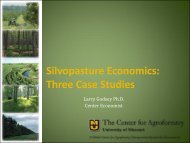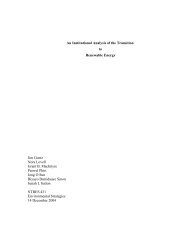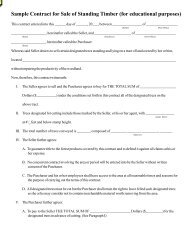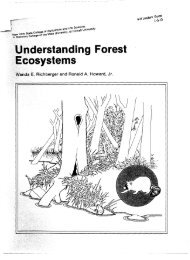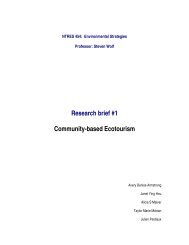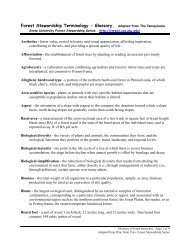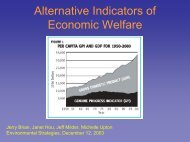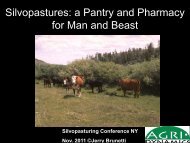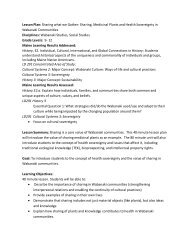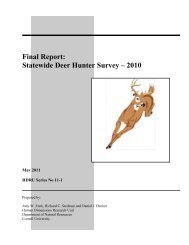Coffee Eco-labeling:
Coffee Eco-labeling:
Coffee Eco-labeling:
Create successful ePaper yourself
Turn your PDF publications into a flip-book with our unique Google optimized e-Paper software.
<strong>Coffee</strong> <strong>Eco</strong>-<strong>labeling</strong>:<br />
Profit, Prosperity,<br />
& Healthy Nature?<br />
Brian Crespi<br />
Andre Goncalves<br />
Janani Kannan<br />
Alexey Kudryavtsev<br />
Jessica Stern
Presentation Outline<br />
I. Introduction<br />
II.<br />
III.<br />
IV.<br />
• Question at hand<br />
• Background of <strong>Coffee</strong> and <strong>Eco</strong><strong>labeling</strong><br />
Environmental Impacts<br />
Socio-<strong>Eco</strong>nomic Impacts<br />
• Growers and Consumers<br />
Conclusions<br />
• Future and Alternative Options
Question at Hand<br />
Is eco-<strong>labeling</strong> of coffee an<br />
effective market incentive<br />
to promote environmentally<br />
friendly production<br />
methods?
Background<br />
• <strong>Coffee</strong><br />
–2 nd most traded<br />
commodity in world,<br />
next to oil<br />
– 5.3 million tons<br />
produced globally and<br />
exported in 2002 (U.N.<br />
Food and Agriculture<br />
Organization)<br />
http://www.jeremiahspick.com/organic.shtml
Background<br />
• <strong>Eco</strong>-<strong>labeling</strong><br />
– A strategy to encourage strong<br />
environmental practices through<br />
incentives for the producer<br />
•Price premium<br />
• Competitive advantage<br />
– Appease pressures from environmentalists<br />
• Future considerations (sustainability)<br />
– Future market concerns<br />
– Conservationist outlook
<strong>Eco</strong>-<strong>labeling</strong><br />
• Not a standard process<br />
– Third party certification<br />
• Own criteria for certification under certain<br />
principles for different aspects i.e. organic<br />
• Credibility is key<br />
– Gives consumer advantage<br />
– Schemes of <strong>Coffee</strong> Labeling<br />
• Fair Trade<br />
• Organic<br />
• Shade Grown
Shade-grown<br />
Fair<br />
trade<br />
Organic
<strong>Coffee</strong> Certification Schemes<br />
• Schemes are not mutually exclusive<br />
– Many growers are certified organic,<br />
shade grown and fair trade<br />
• Must meet criteria for each, but does not<br />
mean being certified as one means you<br />
are or are not certified by another
Fair Trade<br />
• Seeks to offer small farmers and<br />
cooperatives of farmers a fair<br />
price for their coffee<br />
– Ensures access to credit for farmers<br />
among other mechanisms<br />
• Often coexisting with stated<br />
sustainable growing practices<br />
– Modern plantation farming is not<br />
conducive to small farmers due to<br />
high resource costs and involved<br />
methods<br />
http://gbgm-umc.org/nwo/01so/fairtrade.html
Organic<br />
• Grown free of pesticides, herbicides,<br />
fungicides and other chemicals<br />
– Environmental benefits<br />
• Often coexisting with shade grown<br />
certification<br />
• Most developed current certified<br />
coffee market
Shade Grown<br />
• Grown under a canopy<br />
of trees<br />
– The traditional method of<br />
growth before the<br />
modernization of coffee<br />
agriculture<br />
– Typically yields a highquality<br />
product with a<br />
lesser need for chemical<br />
inputs<br />
– Most often organic also<br />
www.coffeesearch.org/politics/shadegrown.jpg
Environmental Impacts<br />
Traditional<br />
Modernized<br />
Perfecto and Snelling. (1995) “Biodiversity and the transformation of a tropical agroecosystems.”<br />
In: <strong>Eco</strong>logical Applications 5: 1084-1097.
Environmental Impacts<br />
• Loss of biodiversity<br />
• Invasive species<br />
• Soil erosion<br />
• Deforestation<br />
• Agrochemical pollution<br />
• High energy demand<br />
But:<br />
• More yield<br />
• Control over ecosystem<br />
• Cheaper production
Environmental Impacts<br />
Working<br />
landscape?<br />
Working for people:<br />
• Food safety<br />
• <strong>Coffee</strong> + fruits + timber<br />
• Natural pests control<br />
• Stable yields<br />
…and for nature:<br />
• No habitat lost<br />
• Conserve species<br />
• Carbon sequestration
Socio-<strong>Eco</strong>nomics<br />
How far does the world-wide<br />
coffee industry extend?
Current trends affecting<br />
growers deal with -<br />
Drive for a better profit, not a<br />
better environment
Flaws in <strong>Eco</strong>-Labeling for<br />
Growers<br />
“In practice, small farmers need<br />
additional help and incentives to<br />
adopt the [bio-diversity friendly]<br />
certification criteria . . . Small farmers<br />
with [conventional polyculture] farms<br />
need to be presented with strategies<br />
to lower the risk of investment . . .<br />
(Gobbi, 2000).”
Flaws in <strong>Eco</strong>-Labeling for<br />
Growers<br />
“The entry cost to organic<br />
production, even subsidized,<br />
appears to be too high for the<br />
smallest producers, but organic<br />
production is a significant option<br />
for the slightly larger producers<br />
(Bray et al. 2002).”
Consumers<br />
Pro-Certification Arguments:<br />
Growers cannot get a premium<br />
Big companies cannot be held accountable<br />
unless they have certification<br />
Confidence that the coffee purchased actually<br />
serves the purpose<br />
Ensures good scientific criteria<br />
Helps make an informed decision
Consumers<br />
Arguments Against Certification:<br />
Certification price is too high<br />
Does not control possibility of fraud<br />
Broker should be certified<br />
Deciding between labels becomes difficult
Consumers<br />
Three approaches:<br />
1. Farmers should not bear the burden of<br />
certification costs.<br />
2. “Relationship coffee” - trading coffee<br />
through known sources; certifying brokers<br />
3. Good quality would ascertain good<br />
premium like gourmet coffee
Consumers<br />
Figure 2: (National <strong>Coffee</strong> Association) Percentages of both awareness and total<br />
purchase of eco-labeled coffee increased from 2003 to 2004.
Drawbacks and Failures<br />
1. Inversion of Values<br />
2. Cost of certification schemes<br />
• Difficult without third party support<br />
3. Certification Methodology<br />
neglecting social relations<br />
4. Organic norms and regulations<br />
across different landscapes
Alternative Certification Systems<br />
Origin:<br />
Southern and Northern countries<br />
Reasons:<br />
• certification costs<br />
• paradigm for ensuring credibility<br />
• more adapted system to local realities<br />
Definition:<br />
A process which generates credibility for the organic<br />
product based on the participation and integration of all<br />
stakeholders who have interest to guarantee the quality of<br />
the product. (Meirelles 2003)
Alternative Certification Systems<br />
Characteristics:<br />
• Involve several stakeholders<br />
• Based on negotiated standards<br />
• Trustworthy relationships<br />
• Attempt to integrate social and environmental concerns<br />
Examples:<br />
• Community Support Agriculture<br />
• Farmers Markets<br />
• Box schemes<br />
• Home deliveries<br />
• Popular fairs<br />
International Workshop on Alternative<br />
Certification
One last thing . . .<br />
We created a web site with<br />
Our paper<br />
Our references<br />
Links to websites<br />
Our PowerPoint<br />
presentation


